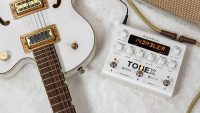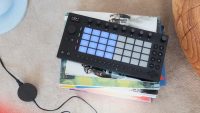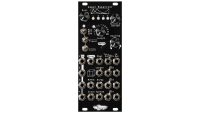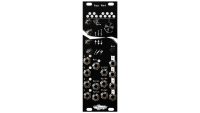Texture synthesizer
REINVENTING A CLASSIC
Beads is a reinvention of Mutable Instruments’ Clouds.
The concept is the same, live granular processing of an incoming audio signal, and the labels on the panel remain familiar.
The similarities stop here. The hardware and software have been redesigned from the ground up, with several goals in mind: a crisper and broader sound palette, more control, better playability, and direct access to exciting new features.
DOTTING THE I’S AND CROSSING THE T’S
Beads’ vastly improved specifications allow a higher audio quality, a longer buffer, the use of better interpolation and anti-aliasing algorithms, and key DSP blocks to run at a faster rate. Granular processing can now go to new territories, such as formants, wavetables, hard-sync-like sounds, or crispy noise.
The range of parameters, their response to the turn of a knob or a CV modulation have all been refined, for new possibilities such as reverse playback or percussive envelopes.
CONTROL, CHAOS AND CHARACTER
Control. To trigger or schedule grains, Beads provides new features to divide or randomize an external clock or trigger stream, spray bursts of grains in response to a gate, or get the grain rate to track a V/O CV or the frequency of an external oscillator.
Chaos. Each key parameter of a grain comes with its own attenurandomizer, which allows direct CV control, CV control of the randomization (spread) of this parameter, or internal randomization using some of Marbles’ algorithms.
Character. Beads provides four audio quality settings, which go well beyond buffer sample rate and bit-depth: they affect the clock of the converters, the amplitude limiting and saturation of the signal path, the tone of the reverb, and additional media-emulation effects. From a pristine digital device to a dirty cassette, through a mode reproducing some of Clouds’ characteristics.
MODES?
Beads can operate as a delay without the need to switch to a different mode: just ask it to play a never-ending grain. Its DENSITY, TIME and SEED controls are repurposed to allow various features such as tap-tempo, beat slicing, time-stretching, or comb-filtering at rates tracking V/O.
Without any audio input, Beads will granularize 8 internal banks of wavetables.
All parameters have a dedicated knob.
Audio acquisition
- Stereo I/O with automatic level detection.
- Manual override of the level detection.
- Automatic mono/stereo switching through patch cable detection.
- Recording time: 4s (48kHz 16-bit, stereo) to 32s (24kHz µ-law, mono).
- Four quality modes, with different tone and reverb characters:
- 48kHz 16-bit
- 32kHz 12-bit with Clouds emulation
- 24kHz 12-bit with a hi-fi dry signal path
- 24kHz µ-law with cassette emulation
- The FREEZE button and the gate input freezes the content of the recording buffer, allowing you to dive into its sonic details.
- Auto-saving of the FREEZE buffer.
Granular synthesis
Three grain generation modes:
- Latched (continuous), with a periodic or randomized rate, tracking V/O.
- Gated, with bursts of grains triggered by the press of the SEED button or an external gate.
- Clocked, with randomization or division of an external clock or trigger signal.
Four grain parameters:
- TIME. Temporal position within the buffer.
- SIZE. Grain duration from 0.03 to 4 seconds, forward or backward playback.
- SHAPE. Morphing between four key shapes of the grain envelope: solid rectangular, snappy decay, smooth bell, or reversed.
- PITCH. With V/O tracking.
Attenurandomizers
Available for each of the four parameters of a grain, sampled each time a grain is started:
- Direct CV control.
- CV control of the amount of gaussian randomization.
- Internal randomization with an independent, uniform or peaky, random source.
Delay
- Control of both the base delay clock rate (DENSITY), and its multiplication (TIME), with optional random taps.
- Tap tempo with the SEED button or an external signal.
- Enveloping of delay repeats, with the SHAPE setting.
- Pitch shifting of the delayed signal, controlled by PITCH.
Signal flow
- Feedback path delay: 1 sample.
- Independent knobs for feedback, dry/wet amount, and reverb amount.
- CV input assignable to each of these three parameters, or to variable combinations of them.
- When unpatched, the R output is summed to the L output.
- Optional generation of a gate signal on the R output.
Specifications
- All inputs: 100k impedance.
- Audio codec: 24kHz, 32kHz or 48kHz, 24-bit.
- 16-bit CV capture.
- Processing rate: audio-rate for the SEED and FREEZE inputs, 4kHz for the CV inputs.
- Latency: 0.25ms.
- CV input range: +/- 8V for grain parameters, +/- 5V for density (with V/O tracking) and assignable CV.
- Internal processing: 32-bit floating point.
IDR 5.385.000





